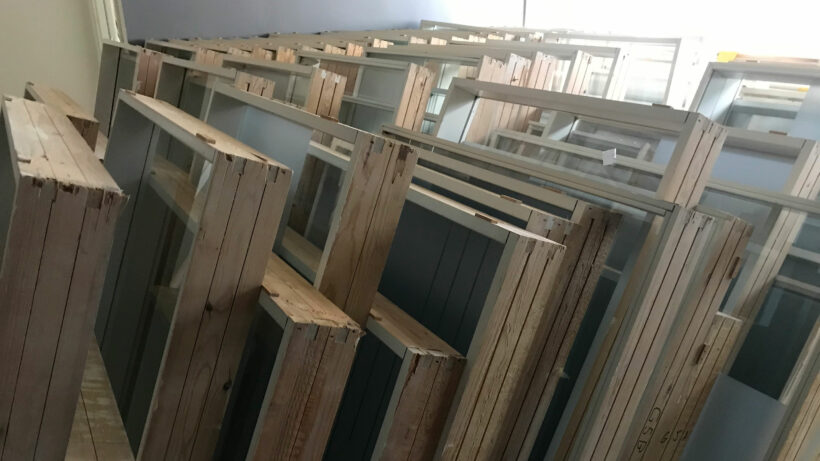
DeepDive: Can everything be reused in a demolition? Kromet in Gothenburg has high ambitions for recycling and reusing
All buildings are essentially temporary houses for materials. After the building has served its purpose, the construction materials and furnishings move into the next part of their ecocycle. Seen from this perspective, demolition jobs are goldmines. When White was on assignment as a recycling and reuse coordinator for Vasakronan at the Kromet office building in Gothenburg, the ambition was to reuse, recycle and upcycle 100% of all the materials. But is 100% really possible – i.e. not wasting a single thing in a demolition?
With the basic view that a building is a material resource, White and Vasakronan are breaking new ground in reuse and recycling when a building is demolished. With a vision of 100% reuse and material recycling, the Kromet office block on the Göta River was taken down piece by piece. While the final figures are not yet in, to date 100 tonnes of material has been reused, and that will only increase by the time the project is finished. All in all, to date the project has saved 200 tonnes of carbon dioxide equivalents through reuse and recycling.
Kromet was built in the 1980s, on the quayside beside the new Hisingen Bridge’s current abutment. The site will soon be home to a brand new building equipped for the future, Kaj (or ‘Quay’) 16. Vasakronan, which as a property company always prefers to preserve and develop its existing properties, first looked into letting Kromet stand. But the high water flows expected in Gothenburg due to climate change made it clear that demolition was the best option from a climate and resource perspective.
With a vision of 100% reuse and material recycling, the Kromet office block on the Göta River was taken down piece by piece.
Rather than demolishing Kromet the conventional way and doing a new build from newly produced construction material, the company opted for a more sustainable approach, where materials from the old building are used for the new one. For example all the stainless steel façade sheets will be reused, and the concrete from Kromet will be ballast in the foundation of Kaj 16, thus enabling a great reduction in the use of finite natural resources.
White’s role in dismantling Kromet was to enable as high a percentage of reuse, recycling and upcycling as possible. This entailed ensuring that dismantling, logistics and storage all worked smoothly, and meticulously assessing the climate benefit of each component. Using a specially developed assessment model, a reuse plan was drawn up evaluating circular material flows, climate benefit and simplicity of dismantling. This made it possible to get an overview of all the building’s constituent components, and how they could be reused.
“We’ve had control over all the materials throughout the process. Initially, a project with such high reuse ambitions requires more time to map out exactly what materials are available. But we’ll soon have all the final results, and it’s already clear that it was time very well spent that will lead to long-term sustainability,” says Karin Hedén, Sustainability Strategist at White.

Vasakronan chose to procure a demolition contractor based on dismantling and reuse aspects. White was responsible for planning and coordinating the reuse, and this also entailed informing other Vasakronan construction and conversion projects – as well as other property owners, suppliers and reuse/recycling firms – what materials were available in Kromet that could be reused or recycled in different ways.
Anna Denell, Sustainability Director at Vasakronan, described the vision of 100% reuse as most definitely ambitious – maybe even unrealistic.
We were aware it would be difficult to achieve 100% reuse, but if we didn’t aim high, we would never get out of our comfort zone. We’re now forcing ourselves to push the boundaries, lift every stone and consider how we can do things differently.
Despite the high level of ambition, total reuse and recycling after dismantling Kromet turned out to be impossible. The 1980s building methods made it impossible to separate materials using modern processes, and some of the products in a building are destroyed during demolition – as indeed was the case with Kromet.
“We tried to reuse the steel frame on the top floor, but full success would have required a highly complicated dismantling process. One of the keys to success in reuse in the future is to consider resource-efficient dismantling already in the original building plans,” says Karin Hedén.
Alongside the many other lessons learned from working on Kromet, this insight is now a key element of future reuse and material recycling initiatives, both for Vasakronan and for reuse coordinator White. Karin Hedén at White is hopeful about the future.
“It’s possible to reuse, recycle and upcycle a lot more than many people think! At Kromet, we and Vasakronan have amassed all kinds of expertise about how we can scale up the reuse approach in the construction phase. The path we’ve now established is the only possible way forward for a sustainable future in our towns and cities, and Kromet is a clear indicator that we must now all help to remove the obstacles.”
Photo: Alana da Silva
Contact Person
